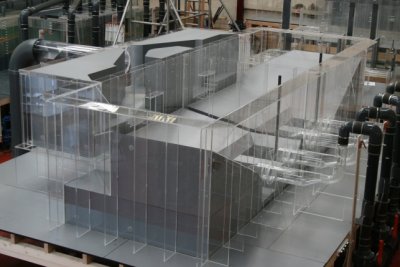- Overview
- Modelling grit, natural and negative buoyancy type debris
Model Construction
Overview
Our models are constructed in clear acrylic material on a substantial timber frame with internal benching and infill fabricated in opaque plastic. The use of acrylic material ensures dimensional stability with the benefit of uninterrupted viewing. Detailed representation of all salient hydraulic features are fabricated and installed within the model i.e. detailed representation of pump units, screens, weirs, flap valves, suctions etc.
Flow is drawn through modelled suctions using external circulating pumps and delivered via orifice plate flow meters and control valves, to a stilling chamber and collection tank. The orifice plate flow meters are constructed in general accordance with BS EN ISO 5617-1 : 1997 and the calibration curve confirmed by in-house volume displacement testing.
Flow patterns are observed by dye tracing, with various water levels achieved by adjusting the volume of water retained within the model,as such, testing is normally undertaken at steady state conditions where inflow is equal to outflow. Velocity measurements are undertaken and abstracted via a miniature propeller meter.
Much has been written concerning the problem of scaling results from a physical model to predict full-size prototype performance. It is apparent that a scaling law for one arrangement may not be appropriate for another and thus no definitive, universally applicable law exists. In areas of the sump remote from pump intakes it is generally accepted that the Reynolds Number should be at least 2,500 to ensure fully turbulent conditions exist.. In studies where vortex formation may occur it is necessary to ensure that the Reynolds Number, at the plane of the pump intake Bellmouth, has a value of at least 30 000 to 40 000 to eliminate viscous effects.
Modelling grit, natural and negative buoyancy type debris

It is important to represent the solid fraction of wastewater in order to highlight potential problems of grit settlement and accumulation. Various methods of representing grit particles may be employed, in our experience grit transport and settlement can be successfully simulated using graded samples of plastic particles. Care must be taken to ensure the particles are of uniform density and free from air (hence, there must be an absence of any air voids within the particles).
It is not possible to linearly scale a grit particle within a reduced scale model as this would result in particles that are too small. This can be overcome by using plastic particles with a lower settling velocity (SG) than the full scale grit particles and by determining the equivalent particle size on the basis of settling velocity. The equivalent full scale size of the model grit particles is determined on the basis of the settling velocity of a typical sewage sample. In accordance with Froude Law Affinity, the model particle settling velocity is multiplied by the square root of the model scale to determine the full scale settling velocity and hence, the equivalent particle size.







